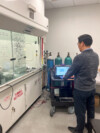U.S. DEPARTMENT OF ENERGY ANNOUNCES $36 MILLION TO ADVANCE MARINE CARBON DIOXIDE REMOVAL TECHNIQUES AND SLASH HARMFUL GREENHOUSE GAS POLLUTION
Funding for 11 Projects Across 8 States to Develop Marine Carbon Capture Technologies, Accelerating Novel Climate Solutions while Supporting President Biden’s Investing in America Agenda to Achieve a Net-Zero Economy by 2050
WASHINGTON, D.C. — The U.S. Department of Energy (DOE) today announced $36 million for 11 projects across 8 states to accelerate the development of marine carbon dioxide removal (mCDR) capture and storage technologies. Funded through DOE’s Sensing Exports of Anthropogenic Carbon through Ocean Observation (SEA-CO2) program, these projects will support novel efforts to measure, report, and validate mCDR and identify cost-effective and energy efficient carbon removal solutions. Advancing innovative approaches like mCDR to slash greenhouse gas pollution is critical to the Biden-Harris Administration’s efforts to tackle the climate crisis and achieve a net-zero emissions economy by 2050.
“Reaching President Biden’s ambitious decarbonization goals and avoiding the worst impacts of climate change will require a wide range of innovative climate solutions, from common-sense approaches like improving energy efficiency to novel applications like utilizing the ocean’s natural carbon removal abilities to reduce greenhouse gas pollution from the atmosphere,” said U.S. Secretary of Energy Jennifer M. Granholm. “With critical funding from DOE, project teams from across the country will develop groundbreaking new technologies to cut emissions that will help combat the climate crisis while reinforcing America’s global leadership in the clean energy industries of the future.”
mCDR techniques take advantage of the ocean’s natural carbon capture and storage processes and, together with other carbon dioxide removal methods, have the potential to mitigate and remove hundreds of millions of tons of harmful carbon dioxide emissions per year. mCDR takes place across large surfaces or volumes of the ocean over comparatively long periods of time. The SEA-CO2 program recognizes that scalable, cost-effective technologies to measure, report, and validate various mCDR approaches are critical to developing this growing industry and supporting President Biden’s clean energy and climate goals.
Managed by DOE’s Advanced Research Projects Agency-Energy (ARPA-E), the teams announced today—including small and large businesses, national labs, and universities—will play a critical role in creating new and appropriately scaled sensors and models that will quantify the effectiveness of mCDR techniques.
One such selected project is the University of Utah’s SEAfloor Self-sustaining CO2 Assessment Probe Edge (SEASCAPE). It will be led by Dr. Hanseup Kim, a USTAR Professor in Electrical and Computer Engineering and the Director for the Utah Nanofabrication Facility along with USTAR Professor Carlos Mastrangelo and Research Assistant Professor Seungbeom Noh. This project will develop a micro-optical, micro-electronic seafloor probe that would extend the longevity and persistence of current-day seafloor carbon storage measurement tools, based on microelectromechanical systems (MEMS) technologies. (Award amount: $2,004,554.)
The proposed probes—deployed in a group across a wide seafloor area—would be inserted directly into the seafloor to measure the accumulation of carbon in ocean sediments for more than a year. University of Utah’s probe would house a newly developed sensor that evaluates carbon dioxide and pH using a novel bubble mechanism, a low-power method that avoids the degradation, calibration, and power issues of conventional sensors.
More information and complete project descriptions for the teams announced today can be found on the ARPA-E website.
Learn more about Electrical and Computer Engineering faculty research topics and discover ways to get involved in undergraduate research.
